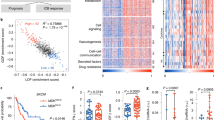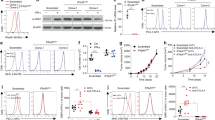Abstract
Melanoma incidence is increasing worldwide, and although drugs such as BRAF/MEK small-molecule inhibitors and immune checkpoint antibodies improve patient outcomes, most patients ultimately fail these therapies and alternative treatment strategies are urgently needed. DNAzymes have recently undergone clinical trials with signs of efficacy and no serious adverse events attributable to the DNAzyme. Here we investigated c-Jun expression in human primary and metastatic melanoma. We also explored the role of T cell immunity in DNAzyme inhibition of primary melanoma growth and the prevention of growth in non-treated tumors after the cessation of treatment in a mouse model. c-Jun was expressed in 80% of melanoma cells in human primary melanomas (n = 17) and in 83% of metastatic melanoma cells (n = 38). In contrast, c-Jun was expressed in only 11% of melanocytes in benign nevi (n = 24). Dz13, a DNAzyme targeting c-Jun/AP-1, suppressed both Dz13-injected and untreated B16F10 melanoma growth in the same mice, an abscopal effect relieved in each case by administration of anti-CD4/anti-CD8 antibodies. Dz13 increased levels of cleaved caspase-3 within the tumors. New, untreated melanomas grew poorly in mice previously treated with Dz13. Administration of anti-CD4/anti-CD8 antibodies ablated this inhibitory effect and the tumors grew rapidly. Dz13 inhibited c-Jun expression, reduced intratumoral vascularity (vascular lumina area defined by CD31 staining), and increased CD4+ cells within the tumors. This study provides the first demonstration of an abscopal effect of a DNAzyme on tumor growth and shows that Dz13 treatment prevents growth of subsequent new tumors in the same animal. Dz13 may be useful clinically as a therapeutic antitumor agent by preventing tumor relapse through adaptive immunity.
This is a preview of subscription content, access via your institution
Access options
Subscribe to this journal
Receive 50 print issues and online access
$259.00 per year
only $5.18 per issue
Buy this article
- Purchase on Springer Link
- Instant access to full article PDF
Prices may be subject to local taxes which are calculated during checkout





Similar content being viewed by others
References
Apalla Z, Lallas A, Sotiriou E, Lazaridou E, Ioannides D. Epidemiological trends in skin cancer. Dermatol Pract Concept. 2017;7:1–6.
Melanoma-Institute-Australia. Melanoma facts and statistics. 2015. http://www.melanoma.org.au/understanding-melanoma/melanoma-facts-and-statistics/.
Barth A, Wanek LA, Morton DL. Prognostic factors in 1,521 melanoma patients with distant metastases. J Am Coll Surg. 1995;181:193–201.
Korn EL, Liu PY, Lee SJ, Chapman JA, Niedzwiecki D, Suman VJ, et al. Meta-analysis of phase II cooperative group trials in metastatic stage IV melanoma to determine progression-free and overall survival benchmarks for future phase II trials. J Clin Oncol. 2008;26:527–34.
Johnson DB, Sosman JA. Therapeutic advances and treatment options in metastatic melanoma. JAMA Oncol. 2015;1:380–6.
Davies H, Bignell GR, Cox C, Stephens P, Edkins S, Clegg S, et al. Mutations of the BRAF gene in human cancer. Nature. 2002;417:949–54.
Luke JJ, Flaherty KT, Ribas A, Long GV. Targeted agents and immunotherapies: optimizing outcomes in melanoma. Nat Rev Clin Oncol. 2017;14:463–82.
Shaulian E, Karin M. AP-1 in cell proliferation and survival. Oncogene. 2001;20:2390–2400.
Ramsdale R, Jorissen RN, Li FZ, Al-Obaidi S, Ward T, Sheppard KE, et al. The transcription cofactor c-JUN mediates phenotype switching and BRAF inhibitor resistance in melanoma. Sci Signal. 2015;8:ra82.
Zhang G, Dass CR, Sumithran E, Di Girolimo NR, Sun L-Q, Khachigian LM. Effect of deoxyribozymes targeting c-Jun on solid tumor growth and angiogenesis in rodents. J Natl Cancer Inst. 2004;96:683–96.
Kappelmann M, Bosserhoff A, Kuphal S. AP-1/c-Jun transcription factors: regulation and function in malignant melanoma. Eur J Cell Biol. 2014;93:76–81.
Santoro SW, Joyce GF. A general purpose RNA-cleaving DNA enzyme. Proc Natl Acad Sci USA. 1997;94:4262–6.
Khachigian LM, Fahmy RG, Zhang G, Bobryshev YV, Kaniaros A. c-Jun regulates vascular smooth muscle cell growth and neointima formation after arterial injury: inhibition by a novel DNAzyme targeting c-Jun. J Biol Chem. 2002;277:22985–91.
Zhang G, Luo X, Sumithran E, Pua VSC, Barnetson RS, Halliday GM, et al. Squamous cell carcinoma growth in mice and in culture is regulated by c-Jun and its control of matrix metalloproteinase-2 and -9 expression. Oncogene. 2006;25:7260–6.
Tan ML, Choong PF, Dass CR. Direct anti-metastatic efficacy by the DNA enzyme Dz13 and downregulated MMP-2, MMP-9 and MT1-MMP in tumours. Cancer Cell Int. 2010;10:9.
Cai H, Santiago FS, Prado-Lourenco L, Patrikakis M, Wang B, Chong BH, et al. DNAzymes targeting c-jun suppress skin cancer growth. Sci Transl Med. 2012;4:139ra182.
Cho EA, Moloney FJ, Cai H, Au-Yeung A, China C, Scolyer RA, et al. Safety and tolerability of an intratumorally injected DNAzyme, Dz13, in patients with nodular basal-cell carcinoma: a phase 1 first-in-human trial (DISCOVER). Lancet. 2013;381:1835–43.
Cao Y, Yang L, Jiang W, Wang X, Liao W, Tan G, et al. Therapeutic evaluation of Epstein-Barr virus-encoded latent membrane protein-1 targeted DNAzyme for treating of nasopharyngeal carcinomas. Mol Ther. 2014;22:371–7.
Krug N, Hohlfeld JM, Kirsten AM, Kornmann O, Beeh KM, Kappeler D, et al. Allergen-induced asthmatic responses modified by a GATA3-specific DNAzyme. N Engl J Med. 2015;372:1987–95.
Kahan-Hanum M, Douek Y, Adar R, Shapiro E. A library of programmable DNAzymes that operate in a cellular environment. Sci Rep. 2013;3:1535.
Hoefer F, Marquardt K, Schmidts T, Domann E, Runkel F. HPLC based single-step kinetic assay to screen the activity of DNAzymes. Anal Methods. 2017;9:697–704.
Hooijkaas A, Gadiot J, Morrow M, Stewart R, Schumacher T, Blank CU. Selective BRAF inhibition decreases tumor-resident lymphocyte frequencies in a mouse model of human melanoma. Oncoimmunology. 2012;1:609–17.
Castle JC, Kreiter S, Diekmann J, Lower M, van de Roemer N, de Graaf J, et al. Exploiting the mutanome for tumor vaccination. Cancer Res. 2012;72:1081–91.
Fidler IJ. Selection of highly aggressive tumour lines for metastasis. Nat New Biol. 1973;242:148–9.
Jin Z, El-Deiry WS. Overview of cell death signaling pathways. Cancer Biol Ther. 2005;4:139–63.
Perales MA, Wolchok JD. CD4 help and tumor immunity: beyond the activation of cytotoxic T lymphocytes. Ann Surg Oncol. 2004;11:881–2.
Zanetti M. Tapping CD4 T cells for cancer immunotherapy: the choice of personalized genomics. J Immunol. 2015;194:2049–56.
Shklovskaya E, Terry AM, Guy TV, Buckley A, Bolton HA, Zhu E, et al. Tumour-specific CD4 T cells eradicate melanoma via indirect recognition of tumour-derived antigen. Immunol Cell Biol. 2016;94:593–603.
Nedergaard BS, Ladekarl M, Thomsen HF, Nyengaard JR, Nielsen K. Low density of CD3+, CD4+and CD8+cells is associated with increased risk of relapse in squamous cell cervical cancer. Br J Cancer. 2007;97:1135–8.
Beatty GL, Winograd R, Evans RA, Long KB, Luque SL, Lee JW, et al. Exclusion of T cells from pancreatic carcinomas in mice is regulated by Ly6C(low) F4/80(+) extratumoral macrophages. Gastroenterology. 2015;149:201–10.
Bhindi R, Fahmy RG, Lowe HC, Chesterman CN, Dass CR, Cairns MJ, et al. Brothers in arms: DNA enzymes, short interfering RNA, and the emerging wave of small-molecule nucleic acid-based gene-silencing strategies. Am J Pathol. 2007;171:1079–88.
Khachigian LM. Catalytic DNAs as potential therapeutic agents and sequence-specific molecular tools to dissect biological function. J Clin Invest. 2000;106:1189–95.
Li Y, Bhindi R, Deng ZJ, Morton SW, Hammond PT, Khachigian LM. Inhibition of vein graft stenosis with a c-jun targeting DNAzyme in a cationic liposomal formulation containing 1,2-dioleoyl-3-trimethylammonium propane (DOTAP)/1,2-dioleoyl-sn-glycero-3-phosphoethanolamine (DOPE). Int J Cardiol. 2013;168:3659–64.
Zhang Z, Zhang S, Wang S. DNAzymes Dz13 target the c-jun possess antiviral activity against influenza A viruses. Microb Pathog. 2017;103:155–61.
Xie J, Zhang S, Hu Y, Li D, Cui J, Xue J, et al. Regulatory roles of c-jun in H5N1 influenza virus replication and host inflammation. Biochim Biophys Acta. 2014;1842:2479–88.
Garg AD, Galluzzi L, Apetoh L, Baert T, Birge RB, Bravo-San Pedro JM, et al. Molecular and translational classifications of DAMPs in immunogenic cell death. Front Immunol. 2015;6:588.
Lardone RD, Plaisier SB, Navarrete MS, Shamonki JM, Jalas JR, Sieling PA, et al. Cross-platform comparison of independent datasets identifies an immune signature associated with improved survival in metastatic melanoma. Oncotarget. 2016;7:14415–28.
Madore J, Strbenac D, Vilain R, Menzies AM, Yang JY, Thompson JF, et al. PD-L1 negative status is associated with lower mutation burden, differential expression of immune-related genes, and worse survival in stage III melanoma. Clin Cancer Res. 2016;22:3915–23.
Mann GJ, Pupo GM, Campain AE, Carter CD, Schramm SJ, Pianova S, et al. BRAF mutation, NRAS mutation, and the absence of an immune-related expressed gene profile predict poor outcome in patients with stage III melanoma. J Invest Dermatol. 2013;133:509–17.
Yan S, Holderness BM, Li Z, Seidel GD, Gui J, Fisher JL, et al. Epithelial-mesenchymal expression phenotype of primary melanoma and matched metastases and relationship with overall survival. Anticancer Res. 2016;36:6449–56.
Liu H, Shen ZB, Wang ZL, Wang XF, Zhang H, Qin J, et al. Increased expression of IDO associates with poor postoperative clinical outcome of patients with gastric adenocarcinoma. Sci Rep. 2016;6:21319.
Kakavand H, Vilain RE, Wilmott JS, Burke H, Yearley JH, Thompson JF, et al. Tumor PD-L1 expression, immune cell correlates and PD-1+lymphocytes in sentinel lymph node melanoma metastases. Mod Pathol. 2015;28:1535–44.
Acknowledgements
We thank Professor Mark J Smyth (Peter MacCallum Cancer Centre, Melbourne) for supply of antibodies, the Biomedical Imaging Facility, UNSW Mark Wainwright Analytical Centre for immunohistochemical staining, and Emeritus Professor Ian Dawes for critical review of the manuscript.
Funding
This study was supported by a Translational Program Grant from Cancer Institute of New South Wales, and Program and Fellowship support from National Health and Medical Research Council of Australia.
Author contributions
LMK designed, directed, and analyzed all aspects of this research; RAS and GMH directed and analyzed various elements in the study; CRP and BHC provided critical intellectual input; HC, E-AC, YL, JS, JE, TJD, PMF, and JSW performed the work and/or analyzed the data.
Author information
Authors and Affiliations
Corresponding author
Ethics declarations
Conflict of interest
LMK has declared I.P. interests in Dz13. The remaining authors declare that they have no conflict of interest.
Rights and permissions
About this article
Cite this article
Cai, H., Cho, EA., Li, Y. et al. Melanoma protective antitumor immunity activated by catalytic DNA. Oncogene 37, 5115–5126 (2018). https://doi.org/10.1038/s41388-018-0306-0
Received:
Revised:
Accepted:
Published:
Issue Date:
DOI: https://doi.org/10.1038/s41388-018-0306-0
This article is cited by
-
Recent advances of DNAzyme-based nanotherapeutic platform in cancer gene therapy
Biophysics Reports (2020)



